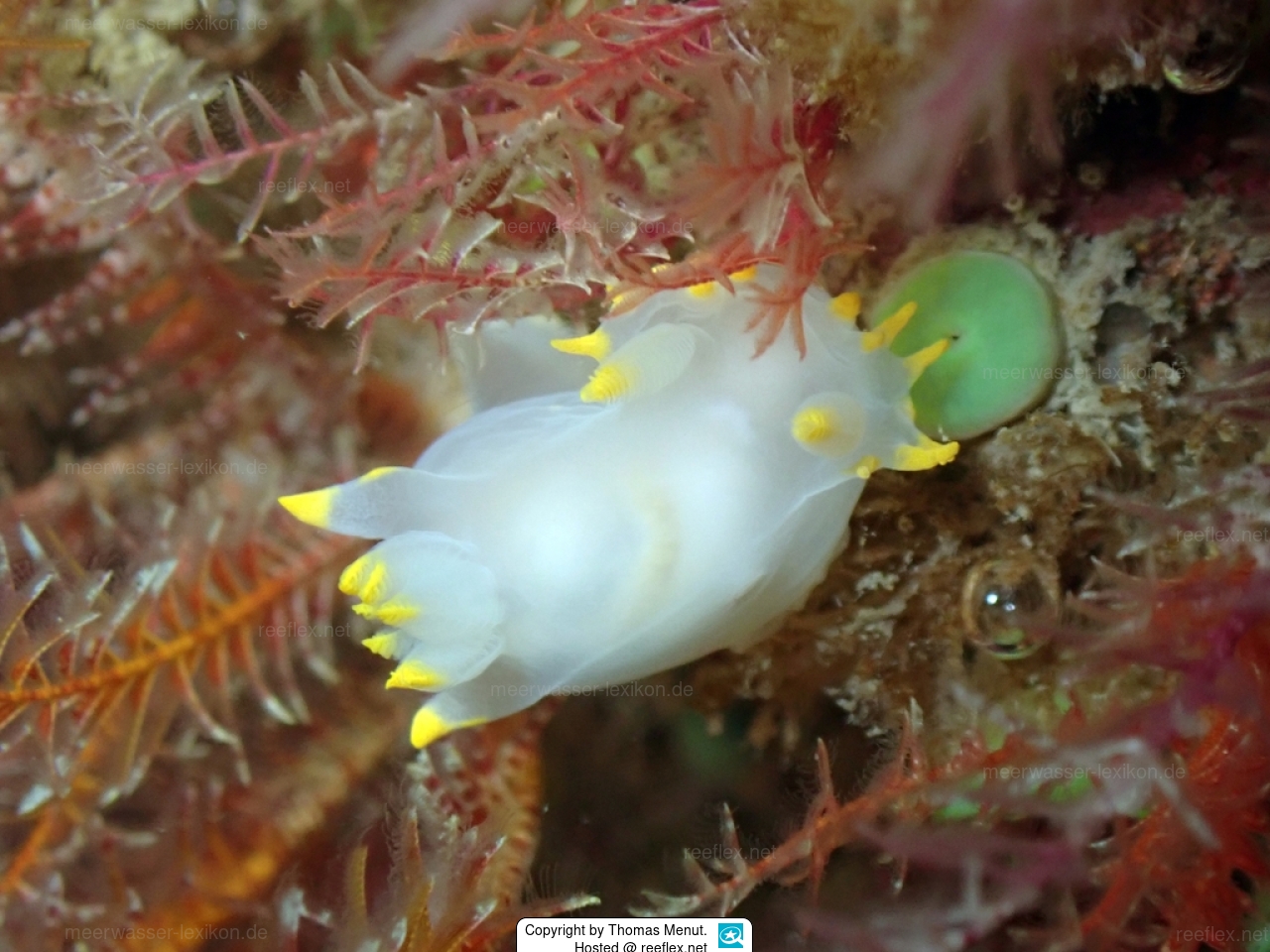Info
Polycera kernowensis Korshunova, Driessen, Picton & Martynov, 2021
Taxonomic note: Korshunova et al. (2021) published their work on the cryptic complex Polycera quadrilineata, in which four species were recognized from the European Atlantic coasts based on a multidisciplinary approach (molecular, morphological, phylogenetic, phylogeographic and ecological) to species identification. In this work, the authors noted that the reports of Polycera faeroensis included another cryptic species (new to science), which they named Polycera kernowensis.
Body with a maximum length of 20 mm, translucent white. The small snail has a forehead veil on its head with up to 9 finger-like, yellow-colored head processes. The rhinophores have between 14 and 15 lamellae with a documented maximum of 22 (Korshunova et al. 2021) with yellow tips. The gills have between 4 and 7 single or sometimes multipinnate white leaves with yellow tips. The gills are flanked by a single lobe, without tubercles or anything else, white in color and with a yellow distal end.
The foot is narrow, translucent white, with a yellow border at the end of the tail, where it merges into a thin yellow band in the middle of the back of the same color. In the front part, the snail is slightly notched in the middle and has two yellow tentacles, slightly thickened to form a double edge. Eye spots are located on the notum, behind the rhinophores, on a light area.
biology
Polycera kernowensis is commonly found in shallow water, having been found at depths between 8 and 30 m on stony and muddy substrates. It feeds on the bryozoans Bicellariella ciliata and Scrupocellaria spp.
etymology
Polycera. From Greek “polys”, many + “keras”, horns.
Kernowensis, derived from an old name for Cornwall, where this species is common.
distribution
With the type locality in the United Kingdom, it has also been found in the Netherlands, northern Spain, Portugal and the southern coast of the Iberian Peninsula on both the Atlantic and Mediterranean coasts.
Taxonomic note: Korshunova et al. (2021) published their work on the cryptic complex Polycera quadrilineata, in which four species were recognized from the European Atlantic coasts based on a multidisciplinary approach (molecular, morphological, phylogenetic, phylogeographic and ecological) to species identification. In this work, the authors noted that the reports of Polycera faeroensis included another cryptic species (new to science), which they named Polycera kernowensis.
Body with a maximum length of 20 mm, translucent white. The small snail has a forehead veil on its head with up to 9 finger-like, yellow-colored head processes. The rhinophores have between 14 and 15 lamellae with a documented maximum of 22 (Korshunova et al. 2021) with yellow tips. The gills have between 4 and 7 single or sometimes multipinnate white leaves with yellow tips. The gills are flanked by a single lobe, without tubercles or anything else, white in color and with a yellow distal end.
The foot is narrow, translucent white, with a yellow border at the end of the tail, where it merges into a thin yellow band in the middle of the back of the same color. In the front part, the snail is slightly notched in the middle and has two yellow tentacles, slightly thickened to form a double edge. Eye spots are located on the notum, behind the rhinophores, on a light area.
biology
Polycera kernowensis is commonly found in shallow water, having been found at depths between 8 and 30 m on stony and muddy substrates. It feeds on the bryozoans Bicellariella ciliata and Scrupocellaria spp.
etymology
Polycera. From Greek “polys”, many + “keras”, horns.
Kernowensis, derived from an old name for Cornwall, where this species is common.
distribution
With the type locality in the United Kingdom, it has also been found in the Netherlands, northern Spain, Portugal and the southern coast of the Iberian Peninsula on both the Atlantic and Mediterranean coasts.







 Thomas Menut, Frankreich
Thomas Menut, Frankreich























